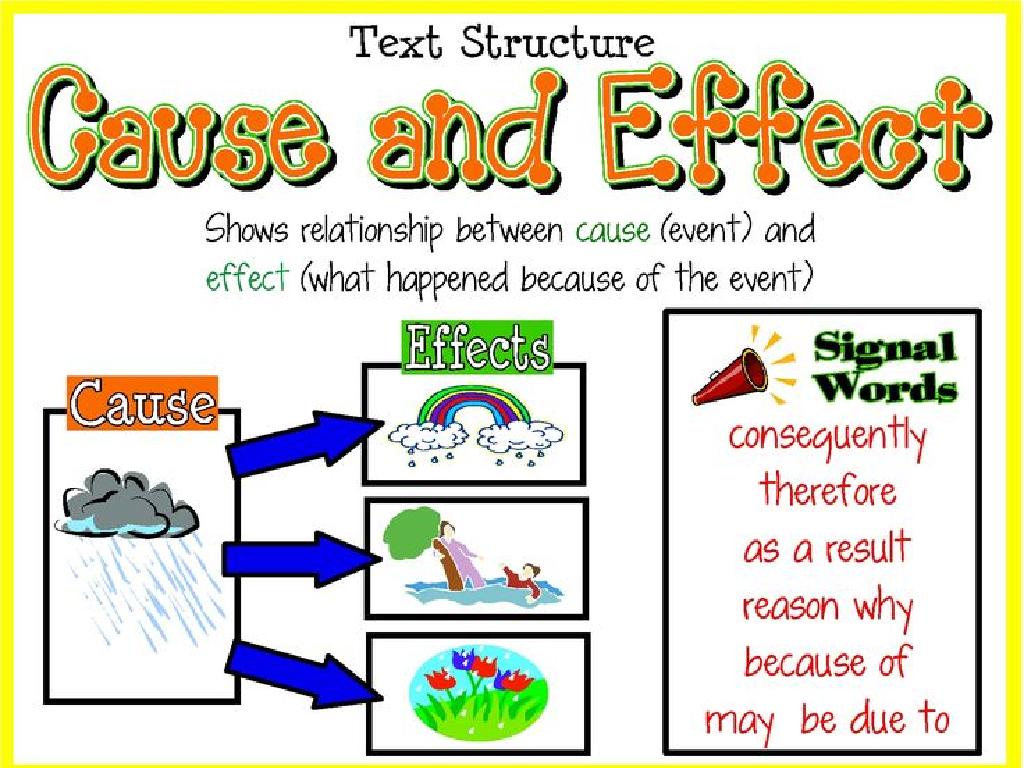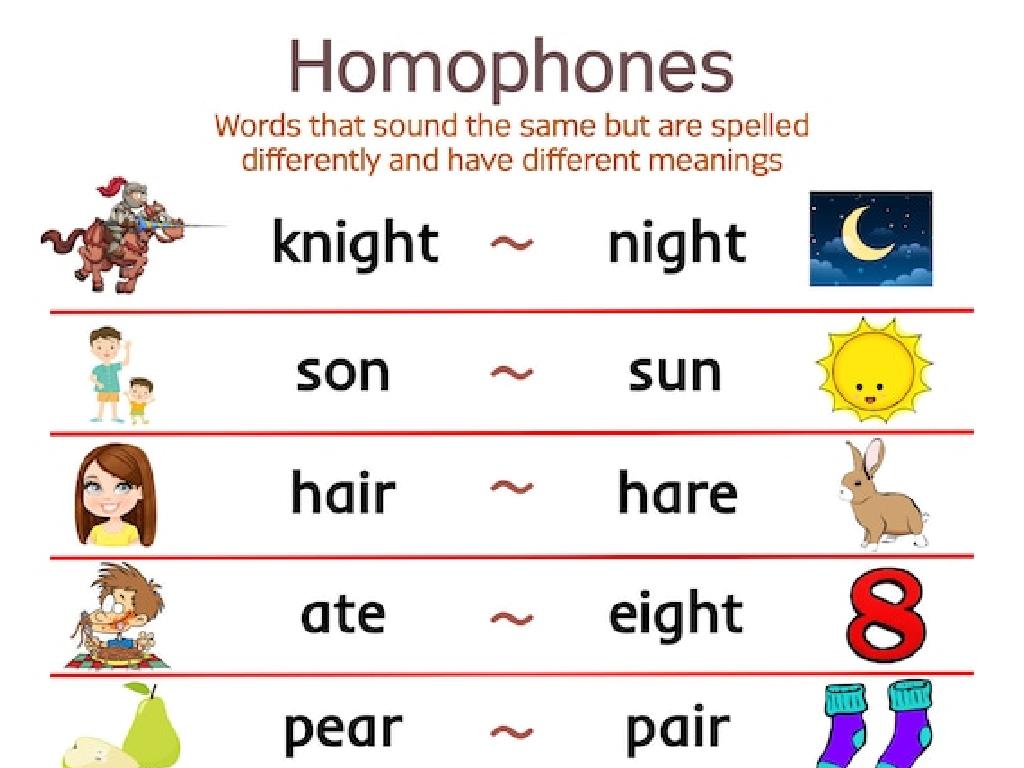Count Forward - Up To 20
Subject: Math
Grade: Kindergarten
Topic: Counting Forward And Back To 20
Summary: Introduce kindergarteners to counting forward up to 20 with this interactive and engaging math lesson. Through songs, movement, counting games, and object-based activities, students will learn to say numbers in sequence, explore number patterns, and recognize quantities. From fun classroom parades to hands-on practice with toys and visuals, this lesson boosts number sense while making math joyful. Perfect for building foundational counting skills aligned with early learning standards.
Please LOG IN to download the presentation. Access is available to registered users only.
View More Content
Welcome to Counting!
– Greet our little mathematicians
– Today’s goal: Count to 20
– We’ll learn to count from 1 to 20
– Counting is a fun numbers game
– Imagine counting steps or claps
– Let’s play and learn together
– We’ll count objects, pictures, and more
|
This slide is designed to introduce kindergarten students to the concept of counting forward up to 20. Start by creating a warm and welcoming environment, addressing the students as ‘little mathematicians’ to foster a sense of excitement about math. Explain that counting is a fundamental skill, similar to a game where we can count various things like steps, claps, or objects. Use interactive activities such as counting aloud with the class, using visual aids like number charts, or physical activities where they can move and count. Encourage participation and make sure to praise their efforts to build confidence. The goal is to make counting feel like a playful and engaging activity rather than a task.
Learning to Count Forward Up to 20
– What does ‘counting forward’ mean?
– It’s saying numbers one after another in the correct order.
– Counting is like climbing steps
– Imagine each number is a higher step on the staircase.
– Let’s count together: 1, 2, 3…
– We’ll start from 1 and say the next numbers up to 20.
– Practice makes perfect!
|
This slide introduces the concept of counting forward to Kindergarten students. Begin by explaining that counting forward is like saying numbers in the order they come, just like when they count toys or steps. Use the analogy of climbing stairs to make it more visual and engaging, as each step represents the next number in the sequence. Practice counting together as a class, starting from 1 and going up to 20. Encourage the students to join in and count aloud. Emphasize the importance of practice, and consider incorporating counting games or songs to reinforce the concept.
Counting Fun: Numbers 1 to 10
– Counting from 1 to 10
– Let’s say the numbers one by one
– Using pictures to help remember
– Each picture matches a number
– Count the balloons together
– How many balloons do you see?
|
This slide is designed to introduce Kindergarten students to the basics of counting. Start by engaging the students with the concept of counting sequentially from 1 to 10. Use colorful and fun pictures, such as balloons, to help them visualize and remember the numbers. Encourage the students to count aloud together as a class, pointing to each balloon as they say the corresponding number. This interactive approach helps reinforce number recognition and the concept of counting order. The activity should be conducted in a playful and supportive environment, ensuring that each student feels comfortable participating.
Counting Stars: Numbers 11 to 20
– Counting up from 11 to 20
– Each number is one more
– After 10, every next number adds one more
– Count stars from 11 to 20
– Visual counting with star images helps understanding
– Practice makes perfect
|
This slide is designed to help Kindergarten students practice counting from 11 to 20, reinforcing the concept that each subsequent number represents one more than the previous number. Use visual aids like images of stars to count together in class, which will help students associate the numbers with actual quantities. Encourage the students to count aloud together and use their fingers if necessary to represent each number. The repetition and visual association are key at this stage for memorizing the sequence of numbers. As an activity, you can have students draw 20 stars and practice counting them, or use physical objects like blocks or beads to count from 11 to 20.
Counting with Objects
– Counting different things
– We can count toys, fruits, or anything around us.
– Let’s count toys and fruits
– For example, count 5 apples or 7 toy cars.
– Count our friends together
– How many friends are wearing red today?
– Understanding quantities
– Counting tells us the total number of items.
|
This slide introduces the concept of counting using familiar objects to make it engaging for Kindergarten students. Start by explaining that counting can be done with any items they encounter in their daily lives. Use visual aids like toys and fruits to demonstrate counting up to 20. Involve the students by counting their classmates or other objects in the classroom. Emphasize that counting is a way to find out how many things are present. Encourage participation by asking the children to count various items in the classroom and discuss the importance of understanding quantities in everyday life.
Let’s Practice Counting!
– It’s your turn to count
– Count items in our classroom
– Find things like blocks or books to count
– Start counting from 1 upwards
– Each number is one more than the last
– Counting forward up to 20
– Practice makes perfect with numbers 1 to 20
|
This slide is designed to engage Kindergarten students in a hands-on counting activity. Encourage them to find various items around the classroom, such as blocks, books, or crayons, and count them aloud together. Remind them that counting forward means starting at 1 and adding one more each time. This activity helps to reinforce their understanding of number sequence and recognition up to 20. As they count, walk around the room to assist and praise their efforts. Offer gentle corrections if needed and celebrate their successes to build confidence.
Counting Forward Game
– Let’s play a counting game
– Use a game board to count
– Each square represents a number up to 20
– Count correctly, move a space
– Practice counting 1 to 20 as you move
– Have fun moving forward!
|
This interactive game is designed to help Kindergarten students practice counting forward up to 20 in a fun and engaging way. Set up a simple game board with numbered spaces from 1 to 20. Students will roll a die or spin a spinner and count out loud the number of spaces they move forward on the board. This activity reinforces number recognition, sequencing, and the concept of one-to-one correspondence between numbers and objects. Encourage students to say the numbers out loud as they move to enhance auditory learning. Offer praise for correct counting and gently correct any mistakes. The goal is to make learning to count a playful and positive experience.
Class Activity: Counting Parade
– Get ready for a counting parade
– Each student receives a number card
– You’ll get a card with a number from 1 to 20
– Line up for the counting march
– Count aloud while parading
– We’ll march and say numbers in order, like a fun game
|
This activity is designed to help Kindergarten students practice counting from 1 to 20 in a fun and engaging way. Before starting, ensure each student understands the concept of counting in sequence. Hand out number flashcards to each student, making sure the numbers are distributed in order. Guide them to line up according to their numbers. As you lead the parade, encourage the students to count out loud in unison, helping them if they miss a number or get stuck. This activity not only reinforces counting skills but also promotes physical activity and coordination. Possible variations include playing music to march to, having students create their own number cards, or reversing the order for counting backward practice.
Review and Goodbye: Counting Stars!
– Great job counting today!
– Review numbers up to 20
– Let’s recite the numbers together one more time.
– Applaud our counting success
– Clap hands for each number we counted correctly.
– You’re all counting stars now!
|
As we wrap up today’s lesson, it’s important to celebrate the children’s achievements in learning to count up to 20. Start by praising their effort and enthusiasm throughout the lesson. Then, lead a quick review by reciting the numbers together, ensuring that the children are confident in their counting skills. Encourage the children to clap for themselves, reinforcing positive self-esteem and making the learning process enjoyable. End the lesson on a high note by acknowledging that each child is now a ‘counting star’, ready to shine with their new numerical skills.





